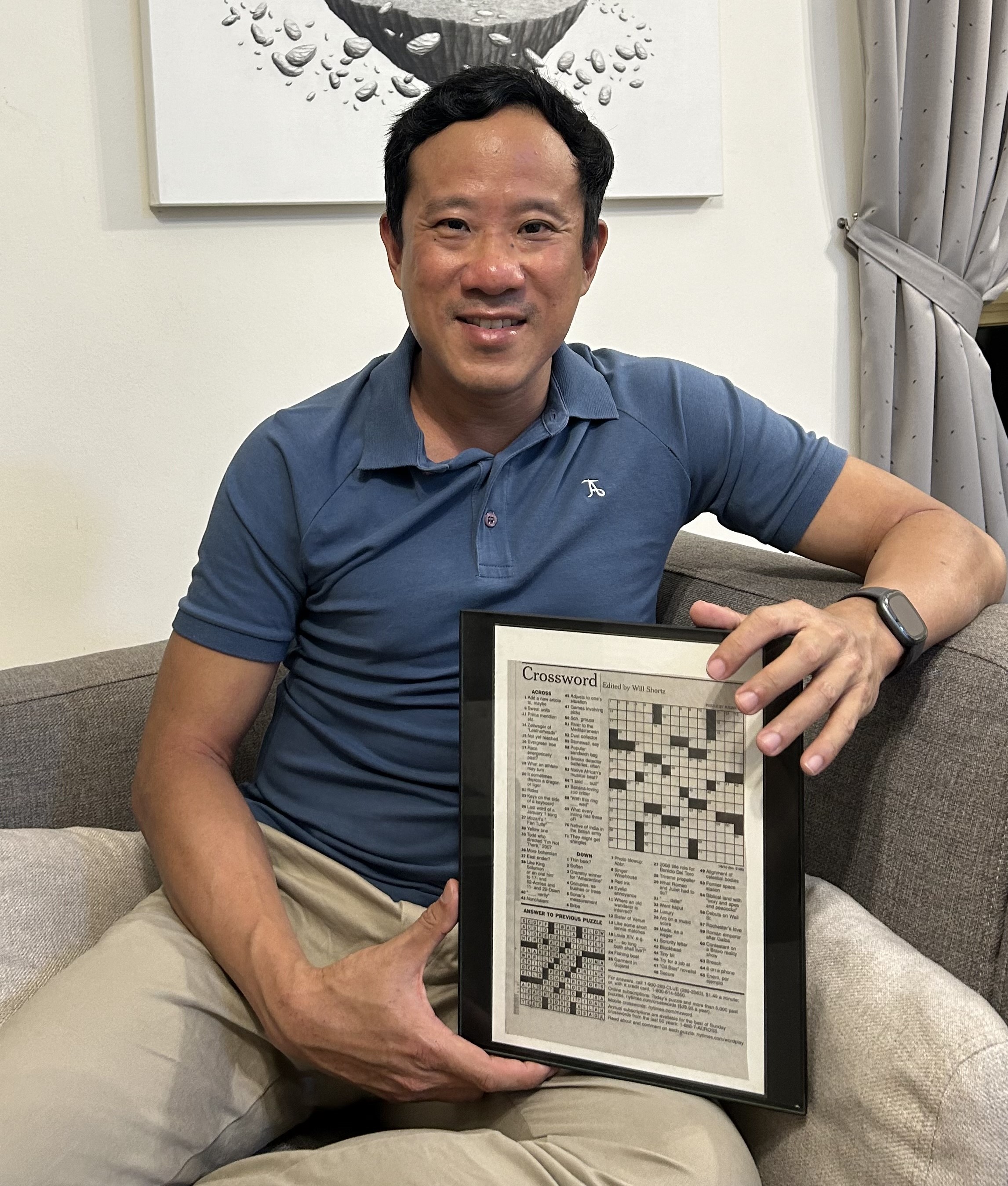3 September 2024
Game for Words
Dr Julian Lim, adjunct professor at NUS, demonstrates the creativity of thinking inside the grid.
 Dr Julian Lim pictured with his first New York Times crossword.
Dr Julian Lim pictured with his first New York Times crossword.
Every week, The New York Times reportedly receives more than 200 submissions from crossword constructors vying to see their work published in the newspaper’s storied pages. Given that a single puzzle is issued daily, the feat of Dr Julian Lim is all the more remarkable.
Over the past 15 years, the adjunct psychology professor at the National University of Singapore (NUS) has had more than 150 of his puzzles printed by leading publications, including The New York Times, the Los Angeles Times, The Wall Street Journal and The Chronicle for Higher Education.
A very good place to start (9 letters)
“I’ve always enjoyed wordplay and trivia,” said Dr Lim, who is also the co-founder of Somnus Sleep Wellness.
Although familiar with British-style cryptics from his secondary school days, the path from puzzle solver to constructor came largely via an American education. As an undergraduate at Duke University, Dr Lim learned to solve crosswords from the campus newspaper while half-listening to his introductory economics lectures.
“I quickly realised how clever the American-style crosswords could be,” explained Dr Lim. “Not only are there many different ways to clue ordinary words, but you also see several cultural touchpoints side by side. The same puzzle could include pop culture, Shakespeare, sports, and politics.”
The 2006 documentary Wordplay led to Dr Lim’s revelation that newspapers often solicit their puzzles from freelancers rather than professionals, motivating him to try crafting and submitting his own.
“One of the difficulties is that the big publications don’t like obscurity, so everything has to be ‘in the language’: solid phrases, simple words, or proper names that are commonly known. Getting everything to interlock in the grid and still be accessible turned out to be really hard.”
His breakthrough came in 2009 when the Los Angeles Times provided his first acceptance. The following year, he made his New York Times debut.

Dr Lim with his mother on a trip to Hong Kong. She encouraged him to read from a young age and inspired his love of language.
Creative spark (11 letters)
Ideas for Dr Lim’s crossword clues and themes come largely from everyday life, be it an offhand idiom or chance sighting. A visit to the museum to view Van Gogh’s The Potato Eaters led to a potato-themed puzzle, while a meal gave rise to one of his favourite clues (Game’s turning point? Answer: rotisserie).
Other clues contain a more personal nod. “My mom loves doing puzzles in general, but she was especially enchanted when I started publishing them,” said Dr Lim. “So I sometimes drop in Easter eggs referencing a shared memory or time we spent together.”
Change over time (9 letters)
Despite the decline of traditional print media, crossword puzzles have maintained, if not grown, in global popularity in recent years with the digital shift. Online platforms and mobile apps have yielded innovations such as hints, checks, timers, and collaborative solving, resulting in a more dynamic form of play.
Likewise, digitalisation has fuelled a proliferation of forums and online communities, enabling constructors to share feedback, resources, and mentorship across geographies. It has also spurred new independent sites that stand as an alternative to the major newspapers, granting constructors greater control over—and increased revenue from—their work. These changes, coupled with the push for more international and minority voices to be represented within crosswords, have created new opportunities for constructors.
“When I first started, I shopped my puzzles around to the local media and was nearly universally rejected,” said Dr Lim. But commissions from independent ventures in Singapore, such as Jom Media, point toward a more hopeful future for Singapore’s puzzle community.

Dr Lim constructs a crossword on the train in the Czech Republic in 2022. Crossword construction software has provided puzzle makers a more efficient alternative to graph paper.
“For the first time, I can finally make a puzzle that contains Singlish phrases, and is more in the language and references of what I grew up with,” said Dr Lim.
One takeaway from his experience?
“If anybody has a quirky thing they enjoy doing, I encourage them to just go for it. It makes Singapore a more interesting place when people pursue their own interests, even if they're not very mainstream.”
Text by Katherine Chinn. Photos courtesy of Dr Julian Lim.
subheadings: beginning; inspiration; evolution